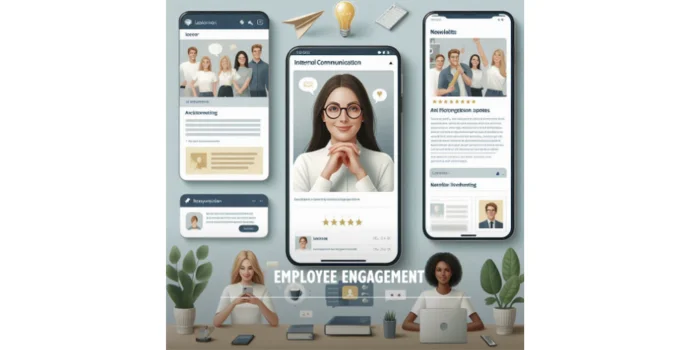
Strong internal branding is no longer a luxury—it’s a necessity in today’s competitive and virtually rooted business world. While external branding often takes center stage, savvy organizations recognize that their internal brand is equally crucial for success. But how can businesses effectively cultivate and strengthen their internal brand? The answer lies in strategic content marketing.
This blog post will explore how medium and large businesses can leverage content marketing to build a robust internal brand and foster employee engagement, alignment, and advocacy.
We’ll delve into practical strategies, real-world examples, and actionable insights to help you transform your internal communications and create a thriving brand culture from within.
Internal branding goes beyond simply communicating your company’s mission and values to employees. It’s about creating a shared identity and purpose that resonates throughout your organization. A strong internal brand:
✍️Did you know? According to an analysis by Peoplematters, for businesses, staff can prove to be influencers for the brand. This underscores the critical role that internal branding plays in business success.
Content marketing isn’t just for external audiences. When applied internally, it can be a game-changer for your brand culture. Here’s why:

Boost your organization by leveraging these powerful content marketing strategies to transform your internal brand and inspire your team.
Encourage employees to create and share content about their experiences, projects, and achievements. This provides authentic perspectives and empowers employees to become active participants in shaping the brand culture.
Example: LinkedIn has pioneered an approach that encourages employees to share their professional journeys and insights directly on the platform. Their strategy involves:
Use various formats—articles, videos, podcasts, infographics—to cater to your workforce’s learning styles and preferences.
Example: Microsoft’s "Story" platform demonstrates the pinnacle of employee-generated content. In its 2023 internal communication report, the tech giant revealed that employee-created content generated more engagement than traditional corporate communications.
Their strategy includes:

Implement interactive platforms like internal social networks or collaboration tools to facilitate two-way communication and real-time engagement.
Example: Starbucks' "Partner Hub" is a central platform for employees to access company news, training materials, and discussions.
Their strategy involves empowering employees through transparent, accessible, and engaging digital collaboration, with:
Leverage content marketing to amplify leadership voices and foster transparency. Regular blog posts, video messages, or Q&A sessions from executives can help bridge the gap between leadership and employees.
Case Study: A Harvard study, highlighted how Google's leadership communication strategy focuses on vulnerability, transparency, and genuine connection.
Their Communication Formats include:
Use data and technology to produce personalized content experiences based on an employee's role, department, or interests, ensuring relevance and impact.
Example: Amazon's learning and development platform uses machine learning to deliver hyper-personalized content experiences tailored to individual employee profiles.
Their strategy includes:
Studies show that companies with a well-executed internal branding strategy see a 20% increase in employee engagement. Here's how to boost employee engagement, aligning your team's efforts with your organizational goals.
|
Read: How LexiConn Helped Amazon Increase Web Traffic with SEO Blogs |
When faced with information overload, it is crucial to prioritize quality over quantity. Stand out by delivering high-quality content that resonates with your audience. Utilizing attention-grabbing headlines and visuals can further enhance your content, making it more engaging and memorable.
To effectively bridge generational gaps in your target audience, it is vital to tailor your content strategy to resonate with different age groups. Understanding the preferred communication styles of each generation can assist you in designing content that appeals to a diverse audience.
Whether it's adapting the tone, language, or platforms used for communication, customization is key to reaching and engaging individuals across various age demographics.
Consistency in branding & messaging is crucial for creating a strong brand identity. Creating style guides and templates ensures that all departments within your organization maintain a cohesive brand voice across different channels and mediums.
By setting clear guidelines for visual elements, tone of voice, and messaging standards, you can present a unified brand image to your audience.
Consider gamification elements or recognition programs to incentivize engagement. Gamification techniques such as quizzes, contests, or interactive features can incentivize users to interact with your content and increase their level of engagement.
Recognition programs that acknowledge and reward active participants can also foster a sense of community and loyalty among your audience.
As technology matures, so will the possibilities for employee Branding through content marketing. Keep an eye on these emerging trends:
Demonstrating the value of internal branding initiatives is crucial for continued investment and support. Here's how to effectively measure your ROI:
Case Study: According to Gallup's research, organizations that implement comprehensive internal branding strategies can experience significant benefits, including up to a 21% increase in profitability and lower employee turnover rates, highlighting the importance of employee engagement in driving organizational success.
Creating partnerships between your internal and external branding efforts can amplify your brand strength. Consider these strategies:
|
Read: How BPCL Engaged with Lexiconn to Curate Content for 500+ Travel Destinations |
Implementing new internal branding strategies often faces resistance. Here's how to navigate these challenges:
Encourage employees to create and share content that reflects your brand values:
Example: Walmart's Spark campaign encourages employees to share stories of making a difference in their communities, reinforcing the company's values internally and externally.
As flexible work arrangements become the norm, adapting your internal branding efforts is crucial:

As we approach 2025, the landscape of internal branding is set to undergo significant transformations. Medium and large businesses must evolve strategies to stay ahead of the curve & retain a competitive edge. Let's explore the key trends and approaches that will define employee Branding success shortly:
By 2025, employees will expect tailored experiences that resonate with their roles, aspirations, and learning styles. Leveraging AI and machine learning, companies must deliver highly curated content and experiences that speak directly to each employee's unique journey within the organization.
Projection: By 2025, 80% of successful internal branding programs will incorporate AI-driven personalization.
In internal branding efforts, virtual and augmented reality will move from novelty to necessity. These technologies will enable:
Fact: The enterprise VR market is expected to grow to $19.5 billion by 2025, with significant applications for employee training and engagement.
In a post-pandemic world, employees increasingly prioritize companies genuinely caring about their well-being. Internal branding strategies must evolve to showcase the following:
Insight: Companies prioritizing employee well-being in their internal branding are projected to see 21% higher profitability by 2025.
As attention spans persist to shrink, the ability to convey brand messages quickly and effectively will become paramount. Expect to see:
Trend: By 2025, 70% of internal communications will be consumed via mobile devices, necessitating a shift to micro-content formats.
In an era of increasing skepticism, authenticity will be the cornerstone of successful employee branding. This means:
Projection: Organizations with authentic internal branding strategies are expected to achieve 40% higher employee retention rates by 2025.
Organizations must embrace and integrate these trends into their internal branding strategies to thrive in this evolving business landscape. The organizations that successfully adapt will foster stronger employee engagement & position themselves as employers of choice in an increasingly competitive talent market.
Content marketing can transform your internal brand, creating a more engaged, aligned, and passionate workforce. By implementing strategic content marketing initiatives, medium and large businesses can foster a strong brand culture that improves employee satisfaction and productivity and translates into a more authentic and compelling external brand presence.
Remember, building a strong internal brand is an ongoing process. Start small, measure your results, and continually refine your approach. With persistence and creativity, you can harness the power of content marketing to create an internal brand that truly resonates with your employees and drives your business forward.
Ready to revolutionize your internal branding efforts? LexiConn also offers a free 30-minute content consultation session to help you with your content strategy.
Visit us at LexiConn or email us at [email protected] to learn how we can help you become brand champions. Let’s work together to unlock the full potential of your internal brand through the power of strategic content marketing.



I have read and accept the Privacy Policy
Read More